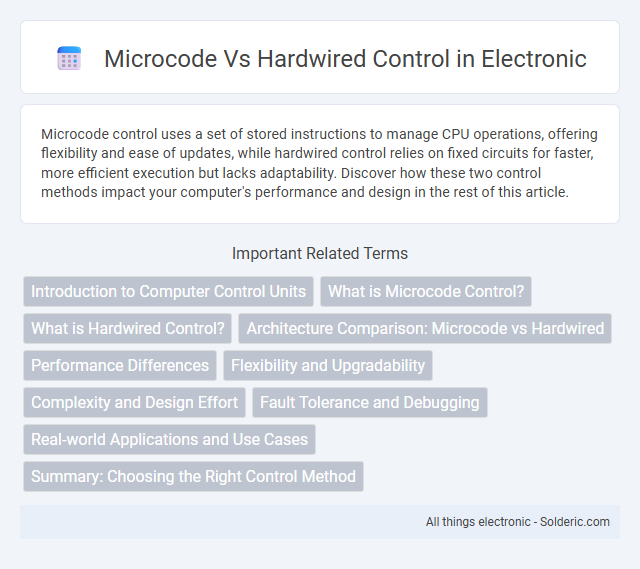Microcode control uses a set of stored instructions to manage CPU operations, offering flexibility and ease of updates, while hardwired control relies on fixed circuits for faster, more efficient execution but lacks adaptability. Discover how these two control methods impact your computer's performance and design in the rest of this article.
Comparison Table
| Aspect | Microcode Control | Hardwired Control |
|---|---|---|
| Definition | Control signals generated by a stored microprogram. | Control signals generated by fixed combinational logic circuits. |
| Flexibility | Highly flexible; easy to modify and update control logic. | Rigid; changes require redesign of hardware. |
| Complexity | Simpler control unit design using microinstructions. | Complex design for complex instruction sets. |
| Speed | Slower due to microinstruction decoding and sequencing. | Faster as control signals are generated directly. |
| Memory Usage | Requires microprogram memory for control storage. | No additional memory needed. |
| Cost | Potentially higher due to memory and microprogramming tools. | Lower for simple designs but can be costly for complex control. |
| Application | Used in CISC processors and systems requiring instruction set flexibility. | Used in RISC processors and applications demanding high speed. |
Introduction to Computer Control Units
Microcode control units use a sequence of microinstructions stored in control memory to generate control signals, providing flexibility and ease of modification. Hardwired control units rely on fixed hardware circuits designed for specific instruction sets, resulting in faster operation but less adaptability. Control units play a crucial role in managing the execution of instructions by directing data flow within the CPU and coordinating internal operations.
What is Microcode Control?
Microcode control is a method of implementing a processor's control unit using a set of instructions stored in a control memory, which directs the execution of machine-level instructions by generating specific control signals. Unlike hardwired control that relies on fixed combinational logic circuits, microcode control offers flexibility for modifying the instruction set architecture without changing hardware. Your ability to update microcode enables easier debugging and enhancement of CPU functionality compared to hardwired control units.
What is Hardwired Control?
Hardwired control is a control mechanism in a computer's central processing unit (CPU) that uses fixed electronic circuits to generate control signals directly. This design ensures faster instruction execution by eliminating the need for microinstructions, resulting in high-speed and efficient control flow. Your CPU's performance benefits from hardwired control when rapid instruction decoding and execution are critical.
Architecture Comparison: Microcode vs Hardwired
Microcode architecture uses a programmable control memory to execute instructions, providing flexibility and easier updates or modifications, while hardwired control relies on fixed logic circuits for faster instruction cycle times but less adaptability. Microprogrammed control units store microinstructions in control memory, allowing complex instruction sets and easier debugging, whereas hardwired control units implement control signals through combinational logic optimized for speed and minimal hardware overhead. Your choice between microcode and hardwired control depends on the need for flexibility in design versus execution speed and hardware simplicity.
Performance Differences
Microcode control offers flexibility in implementing complex instruction sets but generally results in slower execution speeds due to multiple cycles needed for decoding and execution phases. Hardwired control uses a fixed logic design that enables faster instruction processing, providing superior performance especially in time-sensitive applications. Your choice between microcode and hardwired control depends on the required balance between adaptability and speed in the system's instruction execution.
Flexibility and Upgradability
Microcode offers greater flexibility and upgradability by enabling changes to control signals through software updates without altering the hardware, facilitating easier bug fixes and feature enhancements. Hardwired control, built with fixed logic circuits, lacks this adaptability, making modifications costly and time-consuming as they require physical redesigns or replacements. Consequently, microcoded control units are preferred in complex, evolving systems where rapid iteration and customization are critical.
Complexity and Design Effort
Microcode control simplifies complex instruction set implementation by using a programmable memory to store control signals, reducing the design effort needed for instruction sequencing. Hardwired control requires intricate combinational logic and extensive wiring, increasing complexity and making modifications or updates more labor-intensive. The flexibility of microcode allows easier debugging and adaptation, whereas hardwired control demands significant expertise and time for design and changes.
Fault Tolerance and Debugging
Microcode control offers higher fault tolerance by allowing easier updates and corrections through microprogram modifications, enhancing system reliability without hardware changes. Hardwired control, while faster, has limited fault tolerance and is more challenging to debug due to fixed logic circuits. Your ability to diagnose and fix issues improves significantly with microcode control, as it supports straightforward debugging through microinstruction analysis.
Real-world Applications and Use Cases
Microcode control is widely used in complex instruction set computing (CISC) architectures like x86 processors, enabling easier updates and compatibility with legacy instructions. Hardwired control predominates in reduced instruction set computing (RISC) processors, such as ARM and MIPS, for its high speed and efficiency in executing simple, fixed instruction sets. Embedded systems often favor hardwired control for real-time applications requiring low latency, while microcoded control benefits general-purpose CPUs needing flexibility and microprogram updates.
Summary: Choosing the Right Control Method
Microcode control offers flexibility and easier updates by using programmable instructions stored in firmware, making it ideal for complex and evolving instruction sets. Hardwired control provides faster execution through fixed hardware circuits, delivering superior performance for simple, time-critical operations. Selecting the right control method depends on balancing design complexity, speed requirements, and the need for future adaptability.
microcode vs hardwired control Infographic

 solderic.com
solderic.com